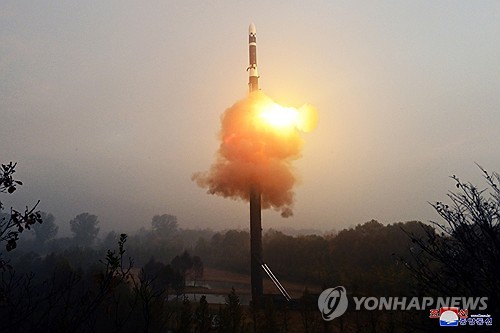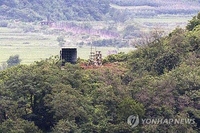Hwasong-19 ICBM is N. Korea's largest long-range missile yet: S. Korean military
SEOUL, Nov. 1 (Yonhap) -- North Korea's new intercontinental ballistic missile (ICBM) launched this week is its largest long-range missile yet, a South Korean military official said Friday, in the latest sign of progress in the recalcitrant regime's missile development efforts.
Earlier in the day, North Korea confirmed it had successfully test-fired the new Hwasong-19 ICBM on Thursday, after the South's military said it had fired a long-range missile on a lofted trajectory into the East Sea.
State media photos showed the missile being fired from an 11-axle transporter erector launcher (TEL) -- assessed to be about 30 meters long -- apparently bigger than any of the North's existing missile launch vehicles.
A South Korean military official told reporters on condition of anonymity that the Hwasong-19 is longer than the country's previously known largest ICBM -- the Hwasong-17. In comparison, the Hwasong-17's TEL, which also has 11 axles, is about 23 meters long.

North Korea fires the new Hwasong-19 intercontinental ballistic missile on Oct. 31, 2024, in this photo released by the official Korean Central News Agency the next day. (For Use Only in the Republic of Korea. No Redistribution) (Yonhap)
The size of the Hwasong-19, powered by solid propellant, also indicates that it has a relatively longer range and larger payload than the smaller solid-fuel Hwasong-18 solid-fuel ICBM that is presumed to be able to target the U.S. mainland.
State media described the Hwasong-19 as the "ultimate" version of its long-range missile series, noting that it renewed the recent records of the country's strategic missile capability.
The missile traversed 1,001.2 kilometers at a maximum altitude of 7,687.5 kilometers and flew for 5,156 seconds, according to state media.
The military official, however, downplayed the North's claim of the missile as its "ultimate" ICBM, noting that it still likely needs to undergo more tests, such as being fired on a normal trajectory.
State media photos also showed the Hwasong-19's nose cone appearing to be more rounded than that of the Hwasong-18, raising speculation that it may be intended to carry multiple warheads inside.
North Korea has sought to develop multiple independently targetable reentry vehicle technology, which allows a single ballistic missile to deliver multiple warheads to different targets, among other advanced weapons since a major ruling party congress in 2021.
The military official said an analysis is under way but noted that North Korea itself has not characterized the latest launch as a test for MIRV technology in its state media report.
In June, North Korea claimed to have successfully conducted a multiple-warhead missile test, which the South's military dismissed as "deception" as the missile exploded in midair.

This photo released by the official Korean Central News Agency on Nov. 1, 2024, shows a transporter erector launcher for the new Hwasong-19 intercontinental ballistic missile the previous day. (For Use Only in the Republic of Korea. No Redistribution) (Yonhap)
yunhwanchae@yna.co.kr
(END)
-
 (3rd LD) 2 dead, about 1,000 evacuated as torrential rains hit central regions
(3rd LD) 2 dead, about 1,000 evacuated as torrential rains hit central regions -
 (2nd LD) Heavy rain soaks Seoul, central regions; 1 dead in wall collapse
(2nd LD) Heavy rain soaks Seoul, central regions; 1 dead in wall collapse -
 Detention warrant issued for ex-first lady Kim's close aide
Detention warrant issued for ex-first lady Kim's close aide -
 Torrential rains batter South Chungcheong Province, triggering flood warnings, evacuations
Torrential rains batter South Chungcheong Province, triggering flood warnings, evacuations -
 (2nd LD) Torrential rains hit Chungcheong provinces; 2 trapped in landslide rescued
(2nd LD) Torrential rains hit Chungcheong provinces; 2 trapped in landslide rescued
-
 (News Focus) Seoul, Washington extend dialogue overtures to Pyongyang; ball in N. Korea's court
(News Focus) Seoul, Washington extend dialogue overtures to Pyongyang; ball in N. Korea's court -
 Lee's presidential win heralds return to engagement with defiant N. Korea
Lee's presidential win heralds return to engagement with defiant N. Korea -
 N. Korea's confirmation of troop deployment spawns speculation about Kim-Putin summit
N. Korea's confirmation of troop deployment spawns speculation about Kim-Putin summit -
 6 months into troop deployment to Russia, N. Korea rewarded with key military tech, economic aid
6 months into troop deployment to Russia, N. Korea rewarded with key military tech, economic aid







